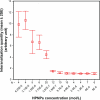Nuclear entry of hyperbranched polylysine nanoparticles into cochlear cells
- PMID: 21468356
- PMCID: PMC3065799
- DOI: 10.2147/IJN.S16973
Nuclear entry of hyperbranched polylysine nanoparticles into cochlear cells
Abstract
Background: Gene therapy is a potentially effective therapeutic modality for treating sensorineural hearing loss. Nonviral gene delivery vectors are expected to become extremely safe and convenient, and nanoparticles are the most promising types of vectors. However, infrequent nuclear localization in the cochlear cells limits their application for gene therapy. This study aimed to investigate the potential nuclear entry of hyperbranched polylysine nanoparticles (HPNPs) for gene delivery to cochlear targets.
Methods: Rat primary cochlear cells and cochlear explants generated from newborn rats were treated with different concentrations of HPNPs. For the in vivo study, HPNPs were administered to the rats' round window membranes. Subcellular distribution of HPNPs in different cell populations was observed with confocal microscope 24 hours after administration.
Results: Nuclear entry was observed in various cochlear cell types in vitro and in vivo. In the primary cochlear cell culture, concentration-dependent internalization was observed. In the cochlear organotypic culture, abundant HPNPs were found in the modiolus, including the spiral ganglion, organ of Corti, and lateral wall tissues. In the in vivo study, a gradient distribution of HPNPs through different layers of the round window membrane was observed. HPNPs were also distributed in the cells of the middle ear tissue. Additionally, efficient internalization of HPNPs was observed in the organ of Corti and spiral ganglion cells. In primary cochlear cells, HPNPs induced higher transfection efficiency than did Lipofectamine(™).
Conclusion: These results suggest that HPNPs are potentially an ideal carrier for gene delivery into the cochlea.
Keywords: cochlea; gene therapy; hearing loss; internalization; nanoparticles; nuclear localization.
Figures










Similar articles
-
Intratympanic delivery of oligoarginine-conjugated nanoparticles as a gene (or drug) carrier to the inner ear.Biomaterials. 2015 Dec;73:243-53. doi: 10.1016/j.biomaterials.2015.09.025. Epub 2015 Sep 24. Biomaterials. 2015. PMID: 26414408
-
Transsynaptic delivery of nanoparticles to the central auditory nervous system.Acta Otolaryngol. 2007 May;127(5):486-90. doi: 10.1080/00016480600895102. Acta Otolaryngol. 2007. PMID: 17453474
-
Hyaluronic acid pretreatment for Sendai virus-mediated cochlear gene transfer.Gene Ther. 2016 Feb;23(2):187-95. doi: 10.1038/gt.2015.94. Epub 2015 Sep 11. Gene Ther. 2016. PMID: 26361273
-
Inner ear therapy for neural preservation.Audiol Neurootol. 2006;11(6):343-56. doi: 10.1159/000095896. Epub 2006 Sep 21. Audiol Neurootol. 2006. PMID: 16988498 Review.
-
Gene therapy for hearing loss: Current status and future prospects of non-viral vector delivery systems.Hear Res. 2024 Nov;453:109130. doi: 10.1016/j.heares.2024.109130. Epub 2024 Oct 17. Hear Res. 2024. PMID: 39427589 Review.
Cited by
-
A novel chitosan-hydrogel-based nanoparticle delivery system for local inner ear application.Otol Neurotol. 2015 Feb;36(2):341-7. doi: 10.1097/MAO.0000000000000445. Otol Neurotol. 2015. PMID: 25587675 Free PMC article.
-
Genetic Hearing Loss and Gene Therapy.Genomics Inform. 2018 Dec;16(4):e20. doi: 10.5808/GI.2018.16.4.e20. Epub 2018 Dec 28. Genomics Inform. 2018. PMID: 30602081 Free PMC article.
-
Nanomedicine strategy for optimizing delivery to outer hair cells by surface-modified poly(lactic/glycolic acid) nanoparticles with hydrophilic molecules.Int J Nanomedicine. 2016 Nov 10;11:5959-5969. doi: 10.2147/IJN.S116867. eCollection 2016. Int J Nanomedicine. 2016. PMID: 27877041 Free PMC article.
-
Toward the Optical Cochlear Implant.Cold Spring Harb Perspect Med. 2019 Aug 1;9(8):a033225. doi: 10.1101/cshperspect.a033225. Cold Spring Harb Perspect Med. 2019. PMID: 30323016 Free PMC article. Review.
-
Inner ear barriers to nanomedicine-augmented drug delivery and imaging.J Otol. 2016 Dec;11(4):165-177. doi: 10.1016/j.joto.2016.11.002. Epub 2016 Nov 25. J Otol. 2016. PMID: 29937826 Free PMC article. Review.
References
-
- Kesser BW, Lalwani AK. Gene therapy and stem cell transplantation: Strategies for hearing restoration. Adv Otorhinolaryngol. 2009;66:64–86. - PubMed
-
- Izumikawa M, Minoda R, Kawamoto K, et al. Auditory hair cell replacement and hearing improvement by Atoh1 gene therapy in deaf mammals. Nat Med. 2005;11:271–276. - PubMed
Publication types
MeSH terms
Substances
LinkOut - more resources
Full Text Sources
Other Literature Sources

